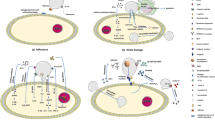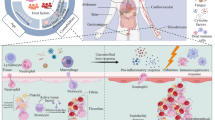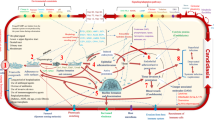Abstract
Introduction
High mobility group box 1 (HMGB1) is an important “late” inflammatory mediator in bacterial sepsis. Ethyl pyruvate (EP), an inhibitor of HMGB1, can prevent bacterial sepsis by decreasing HMGB1 levels. However, the role of HMGB1 in fungal sepsis is still unclear. Therefore, we investigated the role of HMGB1 and EP in invasive C. albicans infection.
Methods
We measured serum HMGB1 levels in patients with sepsis with C. albicans infection and without fungal infection, and control subjects. We collected clinical indices to estimate correlations between HMGB1 levels and disease severity. Furthermore, we experimentally stimulated mice with C. albicans and C. albicans + EP. Then, we examined HMGB1 levels from serum and tissue, investigated serum levels of tumor necrosis factor α (TNF-α) and interleukin 6 (IL-6), determined pathological changes in tissues, and assessed mortality.
Results
Serum HMGB1 levels in patients with severe sepsis with C. albicans infection were elevated. Increased HMGB1 levels were correlated with procalcitonin (PCT), C-reactive protein (CRP), 1,3-β-D-Glucan (BDG) and C. albicans sepsis severity. HMGB1 levels in serum and tissues were significantly increased within 7 days after mice were infected with C. albicans. The administration of EP inhibited HMGB1 levels, decreased tissue damage, increased survival rates and inhibited the release of TNF-α and IL-6.
Conclusions
HMGB1 levels were significantly increased in invasive C. albicans infections. EP prevented C. albicans lethality by decreasing HMGB1 expression and release. HMGB1 may provide an effective diagnostic and therapeutic target for invasive C. albicans infections.





Similar content being viewed by others
References
Wisplinghoff H, Bischoff T, Tallent SM, et al. Nosocomial bloodstream infections in US hospitals: analysis of 24,179 cases from a prospective nationwidesurveillance study. Clin Infect Dis. 2004;39(3):309–17.
Arendrup MC. Epidemiology of invasive candidiasis. Curr Opin Crit Care. 2010;16(5):445–52.
Tragiannidis A, Tsoulas C, Kerl K, et al. Invasive candidiasis: update on current pharmacotherapy options and future perspectives. Expert Opin Pharmacother. 2013;14(11):1515–28.
Nieto MC, Tellería O, Cisterna R. Sentinel surveillance of invasive candidiasis in Spain: epidemiology and antifungal susceptibility. Diagn Microbiol Infect Dis. 2015;81(1):34–40.
De Pascale G, Tumbarello M. Fungal infections in the ICU: advances in treatment and diagnosis. Curr Opin Crit Care. 2015;21(5):421–9.
Méan M, Marchetti O, Calandra T. Bench-to-bedside review: Candida infections in the intensive care unit. Crit Care. 2008;12(1):204.
Drgona L, Khachatryan A, Stephens J, et al. Clinical and economic burden of invasive fungal diseases in Europe: focus on pre-emptive and empirical treatment of Aspergillus and Candida species. Eur J Clin Microbiol Infect Dis. 2014;33(1):7–21.
Rodrigues ME, Silva S, Azeredo J, et al. Novel strategies to fight Candida species infection. Crit Rev Microbiol. 2014;10:1–13.
Netea MG, Van Der Graaf CA, Vonk AG, et al. The role of toll-like receptor(TLR)2 and TLR4 in the host defense against disseminated candidiasis. J Infect Dis. 2002;185(10):1483–9.
Villamón E, Gozalbo D, Roig P, et al. Toll-like receptor-2 is essential in murine defenses against Candida albicans infections. Microbes Infect. 2004;6(1):1–7.
Gil ML, Gozalbo D. TLR2, but not TLR4, triggers cytokine production by murine cells in response to Candida albicans yeasts and hyphae. Microbes Infect. 2006;8(8):2299–304.
Ferwerda G, Netea MG, Joosten LA, et al. The role of Toll-like receptors and C-type lectins for vaccination against Candida albicans. Vaccine. 2010;28(3):614–22.
Akira S, Uematsu S, Takeuchi O. Pathogen recognition and innate immunity. Cell. 2006;124(4):783–801.
Beutler BA, Milsark IW, Cerami A. Cachectin/tumor necrosis factor: production, distribution, and metabolic fate in vivo. J Immunol. 1985;135(6):3972–7.
Wang H, Bloom O, Zhang M, et al. HMG-1 as a late mediator of endotoxin lethality in mice. Science. 1999;285(5425):248–51.
Lin Y, Chen L, Li W, et al. Role of high-mobility group box-1 in myocardial ischemia/reperfusion injury and the effect of ethyl pyruvate. Exp Ther Med. 2015;9(4):1537–41.
Gupta SK, Rastogi S, Prakash J, et al. Anti-inflammatory activity of sodium pyruvate-a physiological antioxidant. Indian J Physiol Pharmacol. 2000;44:101–4.
Ullo L, Ochani M, Yang H, et al. Ethyl pyruvate prevents lethalith in mice with established lethal sepsis and systemic inflammation. Proc Ncad Sci USA. 2002;99(19):12351–6.
Dellinger RP, Levy MM, Rhodes A, et al. Suriving sepsis campaign: international guidelines for management of severe sepsis and septic shock, 2012. Intensive Care Med. 2013;39(2):165–228.
Lionakis MS, Lim JK, Lee CC, et al. Organ-specific innate immune responses in a mouse model of invasive candidiasis. J Innate Immun. 2011;3(2):180–99.
Kang R, Chen R, Zhang Q, et al. HMGB1 in health and disease. Mol Aspects Med. 2014;40:1–116.
Li LC, Gao J, Li J. Emerging role of HMGB1 in fibrotic diseases. J Cell Mol Med. 2014;18(12):2331–9.
Wang H, Vishnubhakat JM, Bloom O, et al. Proinflammatory cytokines (tumor necrosis factor and interleukin 1) stimulate release of high mobility group protein-1 by pituicytes. Surgery. 1999;126(2):389–92.
Andersson U, Wang H, Palmblad K, et al. High mobility group 1 protein (HMG-1) stimulates proinflammatory cytokine synthesis in human monocytes. J Exp Med. 2000;192(4):565–70.
Wu C, Sun H, Wang H, et al. Evaluation of high mobility group box 1 protein as a presurgical diagnostic marker reflecting the severity of acute appendicitis. Scand J Trauma Resusc Emerg Med. 2012;20:61.
Wang XW, Karki A, Du DY, et al. Plasma levels of high mogility group box 1 increase in patients with posttraumatic stress disorder after severe blunt chest trauma: a prospective cohort study. J Surg Res. 2015;193(1):308–15.
Singh A, Feng Y, Mahato N, et al. Role of high-mobility group box 1 in patients with acute obstructive suppurative cholangitis-induced sepsis. J Inflamma Res. 2015;8:71–7.
Abramson N, Melton B. Leukocytosis: basics of clinical assessment. Am Family Physician. 2000;62(9):2053–66.
Pierrakos C, Vincent JL. Sepsis biomarkers: a review. Crit Care. 2010;14(1):R15.
Müller B, Becker KL, Schächinger H, et al. Calcitonin precursors are reliable markers of sepsis in a medical intensive care unit. Crit Care Med. 2000;28(4):977–83.
Persat F, Ranque S, Derouin F, et al. Contribution of the (1–3)-beta-D-glucan assay for diagnosis of invasive fungal infections. J Clin Microbiol. 2008;46(3):1009–13.
Jaijakul S, Vazquez JA, Swanson RN, et al. (1,3)-β-D-glucan as a prognostic marker of treatment response in invasive candidiasis. Clin Infect Dis. 2012;55(4):521–6.
Karageorgopoulos DE, Vouloumanou EK, Ntziora F, et al. β-D-glucan assay for the diagnosis of invasive fungal infections: a meta-analysis. Clin Infect Dis. 2011;52(6):750–70.
Xue J, Suarez JS, Minaai M, et al. HMGB1 as a therapeutic target in disease. J Cell Physiol. 2021;236(5):3406–19.
Wu CX, Sun H, Liu Q, et al. LPS induces HMGB1 relocation and release by activating the NF-ΚB-CBP signal transdution pathway in the murine macrophage-like cell line RAW264.7. J Surg Res. 2012;175(1):88–100.
Wu CX, He LX, Guo H, et al. Inhibition effect of clycyrrhizin in lipopolysaccharide-induced high-mobility croup box 1 releasing and expression from RAW264.7 cells. Shock. 2015;43(4):412–21.
Magna M, Pisetstky DS. The role of HMGB1 in the pathogenesis of inflammatory and autoimmune disease. Mol Med. 2014;20:138–46.
Acknowledgements
We gratefully acknowledge funding from the National Natural Science Foundation of China (No. 81871608, 81171543) to Hang Sun.
Author information
Authors and Affiliations
Contributions
All authors listed, have made substantial, direct and intellectual contribution to the work and approved it for publication.
Corresponding author
Ethics declarations
Conflict of interest
The authors declare that the research was conducted in the absence of any commercial or financial relationships that could be construed as a potential conflict of interest.
Additional information
Handling Editor: Vishukumar Aimanianda.
Publisher's Note
Springer Nature remains neutral with regard to jurisdictional claims in published maps and institutional affiliations.
Rights and permissions
About this article
Cite this article
Wang, J., Wu, C., Wang, Y. et al. The Role of HMGB1 in Invasive Candida albicans Infection. Mycopathologia 186, 789–805 (2021). https://doi.org/10.1007/s11046-021-00595-5
Received:
Accepted:
Published:
Issue Date:
DOI: https://doi.org/10.1007/s11046-021-00595-5




